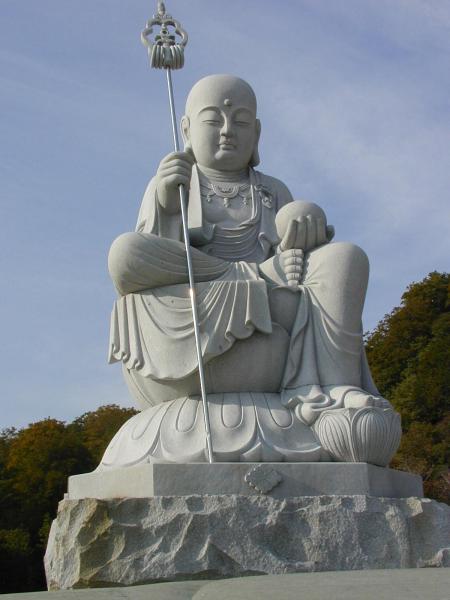 The Shimokita Peninsula (下北半島, Shimokita-hantō) is the remote northeastern cape of the Japanese island of Honshū, stretching out towards Hokkaidō. Administratively the area is a part of Aomori Prefecture.
The Shimokita Peninsula (下北半島, Shimokita-hantō) is the remote northeastern cape of the Japanese island of Honshū, stretching out towards Hokkaidō. Administratively the area is a part of Aomori Prefecture.Shaped like an axe pointing west, the peninsula has a thin "axe handle" connecting the mountainous "axe blade" to the mainland. The coasts maintain a thin scattering of population but the interior is practically uninhabited.
Shimokita is best known as the site of Mount Osore, the mythical Japanese location of the entrance to Hell. The lush Yagen Valley, known for its hot springs, is also located in Shimokita, as is Hotokegaura, wind-carved cliffs said to resemble Buddhas, and the village of Rokkasho, home to a range of nuclear facilities.
The Mountain of Osore is one of the biggest attractions of this area.
 Osorezan is translated as "Fear Mountain", a name that comes in part from the mountain's exceptional landscape. The area is rich in volcanic activity, and a strong smell of sulfur permeates the air. The ground is gray and barren and marked by openings that steam, bubble and blow hot water. Lake Usori, located next to the temple, is colored various shades of blue due to its high sulfur content.
Osorezan is translated as "Fear Mountain", a name that comes in part from the mountain's exceptional landscape. The area is rich in volcanic activity, and a strong smell of sulfur permeates the air. The ground is gray and barren and marked by openings that steam, bubble and blow hot water. Lake Usori, located next to the temple, is colored various shades of blue due to its high sulfur content. Statues of Jizo are commonplace around Osorezan, as are piles of stones and pebbles. The pebbles are offerings to Jizo by parents of dead children in the hope that he will use the stones to help their children gain access to paradise. Brightly colored toy windmills are another common offering frequently seen around Osorezan's grounds.
Every year, Bodaiji's festival (July 22 to 24) attracts the bereaved and those hoping to communicate with lost loved ones through mediums, known as Itako. Itako are blind women who have undergone extensive spiritual training. In order to commune with the dead, they perform austere purification rituals for three months prior to the event and enter into a deep, prolonged trance during the festival.
Also in the Shimokaita peninsula is another beautiful location the Yagen Valley.
There are only two tiny settlements in the entire valley: Yagen Onsen (薬研温泉), a tiny hot-spring hamlet, and Oku-Yagen (奥薬研), population zero but featuring some more hot springs.
The last place anyone visiting the Shimokaita peninsula is Cape Oma (Omasaki).
The cape looks across over the Tsugaru Kaikyo Strait to southern Hokkaido, where the city of Hakodate is visible on clear days. Cape Oma's lookout site is lined by restaurants and souvenir shops selling fish and seaweed products. An observatory building at the cape looks out across the strait.
Besides its geographical notoriety, Oma is well known for its tuna fishing industry. Oma Tuna are among the best and most expensive in Japan, and most make their way to Tokyo's Tsukiji Market and into sushi restaurants across Japan.
I hope everyone enjoys there stay in the Shimokita Peninsula of Aomori and will continue to explore the Tohoku region of Japan.
No comments:
Post a Comment